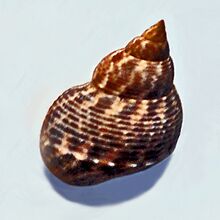Biology:Littoraria scabra
| Littoraria scabra | |
|---|---|

| |
| Scientific classification | |
| Domain: | Eukaryota |
| Kingdom: | Animalia |
| Phylum: | Mollusca |
| Class: | Gastropoda |
| Subclass: | Caenogastropoda |
| Order: | Littorinimorpha |
| Family: | Littorinidae |
| Genus: | Littoraria |
| Species: | L. scabra
|
| Binomial name | |
| Littoraria scabra | |
| Synonyms[1] | |
| |
Littoraria scabra, common name : the mangrove periwinkle, is a species of sea snail, a marine gastropod mollusk in the family Littorinidae, the winkles or periwinkles.[1]
Distribution and habitat
This species is distributed in the Red Sea, the Indian Ocean along Aldabra, Chagos, South Africa , Kenya, Madagascar , the Mascarene Basin, Mauritius, Mozambique, the Seychelles and Tanzania; in the Pacific Ocean along Hawaii and New Zealand.[2] These snails live on rocky shores and on the mangroves.[3]
Description
The size of an adult shell of Littoraria scabra varies between 15 mm and 40 mm.[2] These shells are ovate-conical, without an umbilicus. The outer surface shows a spiral sculpture without nodules, with a pattern of irregular dark stripes.[4] As in other bark-living snail species the shell color is brown. The mouth is rounded and the radula quite long, in order to adapt to the surface or the bark.[5]
Biology
These snails are grazers on the roots, trunks, branches, and leaves of their host plants where they feed on zooplankton, bacteria, algae and mangrove tissues. These generalist herbivores daily vertically migrate along mangrove trees to avoid tidal submersion.[6]
References
- ↑ 1.0 1.1 Littoraria scabra (Linnaeus, 1758). Reid, David G. (2010). Littoraria scabra (Linnaeus, 1758). Accessed through: World Register of Marine Species at http://www.marinespecies.org/aphia.php?p=taxdetails&id=208939 on 6 June 2010 .
- ↑ 2.0 2.1 "Littorinopsis scabra" (in en). Gastropods.com. http://www.gastropods.com/5/Shell_2505.shtml.
- ↑ Atoll research bulletin – National Museum of Natural History (U.S.) no. 495 July 2002
- ↑ Littorinidae at FAO
- ↑ Peter J. Hogarth (2015). The Biology of Mangroves and Seagrasses. Oxford University Press. p. 130. ISBN 978-0-19-871655-6. https://books.google.com/books?id=RfkJCAAAQBAJ&pg=PA130.
- ↑ Andrea C. Alfaro Diet of Littoraria scabra, while vertically migrating on mangrove trees: Gut content, fatty acid, and stable isotope analyses
Bibliography
- Barry Wilson – Australian Marine Shells Part 1
- Deepak Apte – The Book of Indian Shells – Bombay Natural History Society, 1998
- Hsi-Jen Tao – Shells of Taiwan Illustrated in Colour
- Reid, D.G. (1986). The littorinid molluscs of mangrove forests in the Indo-Pacific region – British Museum (Natural History), London
- Robert Tucker Abbott – Seashells of Southeast Asia – Graham Brash, 1991
- Rosewater, J. 1970. The family Littorinidae in the Indo-Pacific. Part I. The subfamily Littorininae. – Indo-Pac. Moll.,2(11):417–506.
- Rosewater, J. 1972. The family Littorinidae in the Indo-Pacific. Part II. The subfamilies Tectariinae and Echininae. Indo-Pac. Moll., 2(12):507–528
Wikidata ☰ Q3704128 entry
 |


